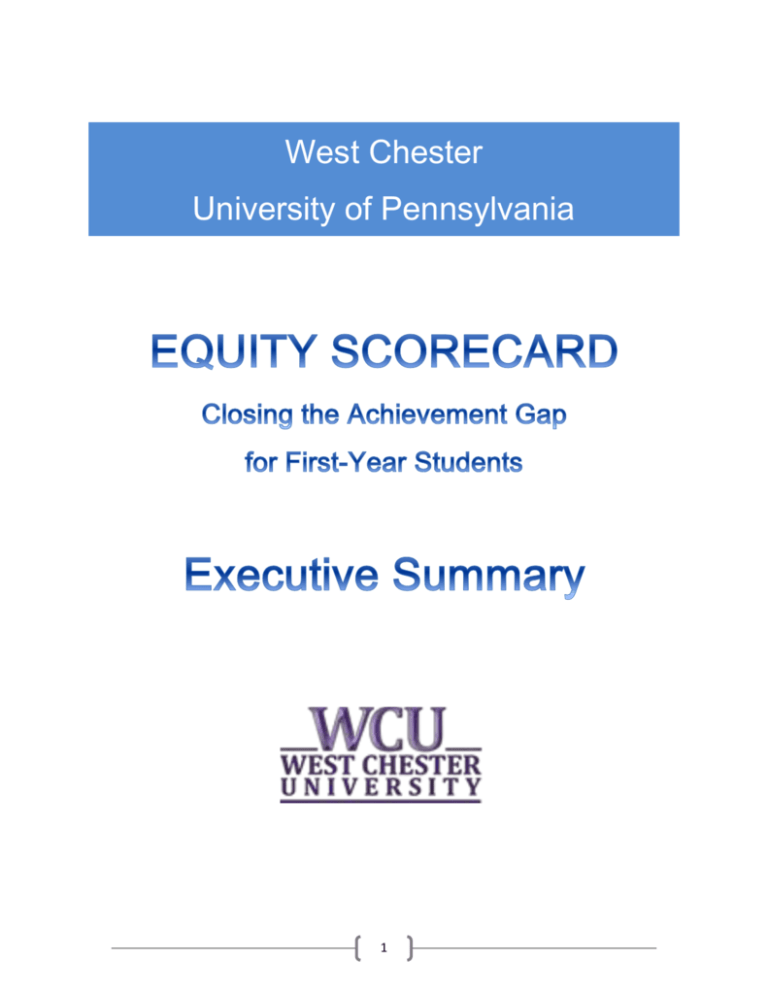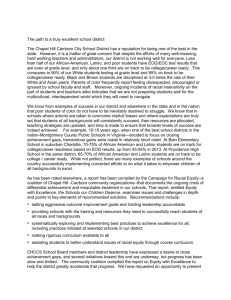WCU Equity Scorecard Retention Completion Exec Summary
advertisement

West Chester University of Pennsylvania 1 Table of Contents Introduction Executive Summary Focal Efforts 1 and 2 Appendices A. Evidence Team 2 Introduction Together with the other thirteen institutions of the Pennsylvania System of Higher Education (PASSHE), WCU is participating in the Center for Urban Education (CUE) Equity Scorecard project. The Equity Scorecard (ES) project is a data-driven, organizational learning process designed to foster institutional change through identifying and eliminating racial disparities among college students. Consistent with WCU’s mission to provide access and high-quality undergraduate education, the aim of this project is to identify structurally hidden and unintended inequalities leading to racial disproportions in the following: access to the university, retention, degree completion, and involvement in high impact activities, such as internship, honors, and undergraduate research. The ES project promotes the principle of equity-mindedness. In this way, our focus is on institutional barriers to student excellence, rather than on potential deficits among individual students. Compensatory programs that aim to eliminate racial/ethnic student deficits alone are not sufficient to bring about equity in student outcomes. By identifying and eliminating unintended structural inequalities that are obstacles to equity at WCU, we are better positioned to effect and sustain systemic change. Working collaboratively with campus administrators, staff, and faculty, the 12-member ES evidence team began its work in January 2012. To date, the ES evidence team has completed Phase I – Access. What follows is the result of the inquiry process for Phase II – Retention and Completion. Executive Summary The Equity Scorecard inquiry process finds that there are two clear risk factors that decrease the probability of second- to third-year retention and of graduation within 6 years: 1) failing to earn 30 credits by the end of the first college year and 2) not having a declared major by the end of the first college year. The cumulative effect of these risk factors is striking and is likely to contribute to the identified racial equity gap in retention and in completion. At present, a large number of URM students enter WCU without a major (i.e., undeclared) and many of these students also enter the university as motivation students (FY4 admission status). Currently there is no policy in place to move our undeclared students to a major early. In fact, several well-intentioned policies, structures, and educational core issues may impede this process. First, there are often not enough Q and basic foundations courses to accommodate all of our newly admitted students who require these courses. Second, departments are not required to have a plan in place to accommodate internal transfers, making it more difficult to move students out of “undeclared” into a major. Third, there is a policy in place to restrict the number of credits motivation (FY4) students can complete in their first college year. 3 The following recommendations focus on reducing the risk factors identified above while supporting motivation students as they transition to college to encourage academic success: The policy regarding Motivation (FY4) students needs revision, to allow them to complete more than 12 credits per semester in their first college semester. The revised policy should encourage all students (including Motivation students) to complete 30 credits and to declare a major (or a pre-major) by the end of their first college year. Additional consideration is needed to draft a plan for how to better support Motivation (FY4) students in achieving these goals with a GPA of 2.75 or higher. All departments need to develop a written policy (approved by their Dean) for the admission of internal transfer students at the completion of 30 credits. The registration policy should be revised to allow students to take their Q courses as soon as possible or allow students to show completion of the necessary developmental course at the community college level. This will necessitate provision of enough sections to meet this need. A tutoring requirement for Q courses should be implemented. Additional resources should be provided to the Writing Center to support tutoring in writing and to the LARC to support tutoring in math. Greater information should be provided to students regarding challenge exams and their importance. A mathematics challenge exam should be created, which would allow for more relevant placement. All departments should be required to identify hidden curricular barriers that affect URM student academic performance and progress. All departments should develop action plans to eliminate those hidden barriers and monitor impact on their URM students. Departments should examine racial inequity in student success for all “gatekeeper” courses and develop a plan for assisting students through these courses (e.g., tutoring, study groups, peer support). There is a sizable equity gap for retention and completion for motivation students (FY4), yet no equity gap in retention or completion for ADP students (FY2 and FY3). This is surprising given the fact that that SAT scores are higher for our FY4 students compared to our FY2 and FY3 students. There are several differences in the early experiences of FY2/FY3 students and FY4 students that may be responsible for the retention/completion differences identified. First, as discussed earlier, FY4 students are restricted in the number of credits they are allowed to complete in their first college year, hindering their ability (if not preventing them) from earning 30 credits by the end of their first year. ADP students are not restricted in the number of credits they earn in year one. Second, ADP students are required to engage tutors to support their early course work. Not only does this appear to advantage ADP students in the courses for which they are receiving tutoring, but it also appears to increase their comfort in requesting tutoring for additional courses. Further, ADP students have the support of peer mentors, a specially designated academic advisor and counseling psychologist, and an academic counselor. Very little data evaluating the effectiveness of WCU special programs in closing the equity gap in retention and 4 completion are collected or are available, restricting our ability to fully understand how any one special program may contribute to closing the racial equity gap in student success. The following recommendations focus on further supporting special programs within the university that appear successful in closing the equity gap in retention and completion for ADP students (FY2/FY3), as well as strengthening other special programs that have the potential of supporting students beyond the first college year (e.g., EAP, OMA): All WCU special programs should develop a comprehensive plan to assess key performance indicators, such as impact on fall-to-spring retention of participants in the first year, longer term impact of special program on second- to third- year retention and six-year graduation rates, actual participation in special program activities, etc. The Office of Multicultural Affairs (OMA) Mentoring Program should aim to increase its reach of the incoming URM population to at least 50% over the next three years and be given the resources and support to facilitate this increase in outreach and programming. The OMA should improve their visibility among academic departments and programs to increase effectiveness in their advocacy of URM student issues, as well as to increase recruitment of faculty/staff mentors. This program should bridge Student Affairs and Academic Affairs. The Early Alert Program (EAP) should be expanded to include gatekeeper courses for majors. Resources and support should be expanded to facilitate this increase in programming and make funding available for this very successful program permanent. Additional tutoring staff should be funded and provided with the necessary resources to expand services at the Learning and Resource Center (LARC). University data practices may be unintentional obstacles to closing the racial equity gap in second- to third-year retention and in six-year graduation rates. First, at WCU, retention is reported (primarily) by tracking students based on the department/program in which they enter the university. Movement between majors/departments/programs is not captured in these analyses. Second, there is little encouragement or incentive for departments, programs, or colleges to regularly attend to data that focuses attention on racial equity in retention and completion. Third, responsibility for monitoring retention and completion (and the equity gap) is distributed throughout the University. In this case, distributed leadership - spanning across both Academic Affairs and Students Affairs - may result in this important aspect of campus life getting somewhat lost in the shuffle of a rapidly growing university environment. The following recommendations focus on changes to the university self-assessment and data reporting practices that may assist in closing the racial equity gap in retention and completion: A cabinet level administrator who is responsible for retention and graduation -- who crosses Student Affairs and Academic Affairs -- is recommended to monitor the closing of the racial equity gap and to revisit support that is given to initiatives aimed at closing the racial equity gap in student success (and maintaining equity moving forward). This change to the University’s organizational structure should facilitate greater communication and coordination across units that share the common explicit goal of closing the equity gap and supporting student success 5 (i.e., Admission, Financial Aid, Registrar, Act 101/ADP, Pre-Major Academic Advising, Honors, OSSD, First Year Interest Groups, LARC, OMA, New Student Programs). A half-time faculty member (3-year term) should be charged with the responsibility of guiding colleges, departments, and programs in developing a plan, implementing a plan, and collecting data to monitor the closing of the racial equity gap in student success. Reporting of the racial equity gap for retention and graduation should occur on a regular basis at the level of the college and the department and for every program within Academic Affairs and within Student Affairs. Regular coordination between Student Affairs and Academic Affairs is needed to make retention and completion efforts more intentional, systemic, and less isolated among specific programs or areas. Departments should add fields to all regular reports for student race. Training, support, and resources (e.g., release time) should be available for departments to develop a strategic plan for identifying and improving racial equity gaps in access, retention, and completion based on best practices within WCU and best practices at other universities. Departments should be required to submit an annual report to the university assessing the racial equity gap in access, retention, and completion within the department and describing the status of programs planned and implemented to reduce racial equity gaps and/or maintain racial equity within the undergraduate experience. Revision of University data practices is recommended – develop a metric that looks at total enrollment of a program/department by FTE. The new model needs to capture the movement of students in and out of a major. On average, students meet with an advisor for 15 minutes or less. Although training is available for advisors, few faculty members take advantage of this training. This may be, in part, because advising is not included in the faculty evaluation process. The result is considerable variability in advising load and advising policy from department to department and from advisor to advisor. Moreover, faculty advisors are likely to be far more knowledgeable about the requirements of a major and career planning within that major/discipline than they are about general education requirements and other possible major or career choices that students may want to consider early in their college experience. The distributed nature of advising at WCU has clear advantages for the advanced student (e.g., allows students to forge a relationship with a faculty member in his/her discipline/major). The advantages to students making the initial transition to college are less clear. The following recommendations focus on changing the university’s advising structure: The University should adopt a philosophy of intentional/intrusive advising, based on the standards set by the National Academic Advising Association. Students should choose an intended major to “explore” when first entering the university. During their first year students will be advised by a PMAA advisor with expertise/interests in the college that the student has identified as housing his/her intended major (e.g., undeclared – COE, undeclared -- CAS, undeclared – CBPA, undeclared – CVPA, undeclared – CHS). 6 All new students should be advised by Pre-major Academic Advising (PMAA) during their first college year. PMAA advisors have clear expertise in general education requirements and are best positioned/trained to assist students in choosing a major area of study at the university. This change will also necessitate increasing the PMAA staff to accommodate advisement of additional students. All students should be required to declare a major no later than at the completion of 30 credits. At that time, the student will transition to an advisor within his/her major program. Students will then have access to a faculty mentor and an advisor with expertise in his/her major area of study. An advising liaison should be assigned to each college to assist in transitioning URM students from undeclared to a major, and to assist with college/department planning regarding the number of courses necessary for students in their first two college years (e.g., Q courses, foundational courses, etc.). New Student Programs (NSP) is primarily focused on providing a mandatory orientation to first year students in June (one day) and August (two day pre-semester), and general programming into the first year. There is little intentional integration of Academic Affairs and the academic experience (intervention and advocacy around retention/completion) into the academic year work of the NSP office. The NSP director reports to the AVP for Student Affairs and has no reporting lines (formal or informal) to Academic Affairs. Moreover, WCU charges a separate fee for orientation not included in the admissions deposit or the aggregated fees. Thirty-five percent of new first-year students neither pay the orientation fee, nor request a payment plan for their orientation fee, by the first orientation date (i.e., published deadline). Students with limited funds seem to postpone orientation until later in the summer. The following recommendations focus on changing New Student Programs: The orientation fee should be integrated into the admission deposit and not charged separately. The NSP must be an integral element of the retention efforts; thus, that office should receive central funding. The University should develop a First-Year Experience (FYE) course specific to each college and includes students’ academic advisors as part of the course. The University should have a more comprehensive approach to orienting new students to college life, particularly URM and first-generation students. A systematic, coherent, first-year experience program should include not only a FYE course, but also a structured progression of activities that build on each other throughout the college experience (e.g., second year experience course, peer mentoring in the 2nd or 3rd year, etc.). 7 Indicator Baseline Goal 1 Goal 2 Equity Focal Efforts Focal Effort #1 Focal Effort: Equity Gap: Close Equity Gap in African American/Latino students’ second- to third-year retention rate from 86.1% (3-year average) to 91.3% by the incoming class of 2013. Of the 720 African American/Latino students who began their 2 nd college year between 2008 and 2010, only 86.1% persisted to Fall year 3. In relation to the 91.3% average, we have a 5.2% gap. In order to close this gap we need to retain an additional 13 African American/Latino students from year 2 to year 3. – 5.2% for African American/Latino students Equity Goal #1 Evaluation Indicator Baseline Goal Fall 2013 Goal Fall 2014 EQUITY Fall 2015 86.1% 87.8% 89.5% 91.3% 207/year 211 215 220 3-year average 2009-12 African American/ Latino second-tothird year retention rate African American/ Latino second-tothird year retention number 8 Focal Effort #2 Focal Effort: Equity Gap: Close Equity Gap in African American/Latino students’ 6-year graduation rate from 55.6% (3-year average) to 67.5% by the incoming class of 2013. Of the 700 African American/Latino students who entered the University between 2004 and 2006, only 55.6% completed their degree within 6 years. In relation to the 67.5% average, we have an 11.9% gap. In order to close this gap we need to graduate an additional 28 African American/Latino students within a 6-year period. – 11.9% for African American/Latino students Equity Goal #2 Evaluation Indicator African American/ Latino six-year retention rate African American/ Latino six-year retention number Baseline 3 year average 2004-06 Goal 1 Year 2014 Goal 2 Year: 2015 EQUITY Year: 2016 55.6% 59.8% 63.6% 67.5% 130/year 140 149 158 9 APPENDIX A Equity Scorecard Evidence Team Idna M. Corbett – Dean, Undergraduate Studies And Student Support Services Vanessa K. Johnson – Professor, Department of Psychology Lisa Yannick – Director of Institutional Research Nilima Inamdar – Research Analyst Linda T. Adams – Dean, College of Health Sciences Timothy Brown – Chair, Department of Communication Studies Joanne Conlon – Director of Pre Major Academic Advising Jacqueline Hodes – Assistant Professor, Department of Counselor Education Kathleen Jackson – Chair, Department of Mathematics Janet Lacey – Professor, Department of Health Querida Lugo – Associate Director, Office of Multicultural Affairs Rodney Mader – Professor, Department of English / Director of General Education Marion McKinney – Director, Residence Life and Housing 10






